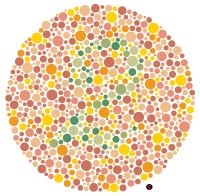|
What does Color Blindness mean? What does it mean to your child and his or her future if they have Color Blindness or a Color Deficiency?
Color Blindness is the inability to appreciate any color. Color deficiency is the inability to discriminate certain colors. There are varying degrees of Color Deficiency depending on the extent of missing Cones or shifting of sensitivity of these Cones. The visible spectrum, which ranges in wavelength from 400 to 700 nanometers, is part of the electromagnetic spectrum. The reason why that light range is visible to us is because it is the least absorbed by sea water. Light waves outside the range of the visible spectrum (like ultraviolet and infrared) are mostly absorbed by sea water. For this reason, the Cones in our retinas evolved to be sensitive to the more available visible spectrum light waves. The acronym frequently used for the visible spectrum is ROY G BIV, which represents red, orange, yellow, green, blue, indigo, and violet. If your child has Color Blindness or has a Color Deficiency, his or her selection of career options will be limited by this condition. Certain occupations such as pilot, train conductor, and electrician require the processing of color information and thus normal color vision. Those with Color Blindness or Color Deficiency cannot perform critical tasks as well and may experience the following difficulties with color information: Unfortunately, the problems that color defectives have with color vision have been discovered because some mishaps have been linked to Color Deficiency. For example, Color Deficiency was cited in the New Jersey train crash in February 9, 1996. The train engineer, who had ran a red signal, caused a collision that killed him and two other people. He had diabetes and had kept his condition, and the fact he was experiencing vision loss, a secret for nine years. How do Cones work?
Our ability to distinguish colors depends on three cones: red Cones, green Cones, and blue Cones. Red Cones outnumber green cones 2:1. Red and green Cones combined outnumber blue Cones 10:1. Also, blue Cones are absent from the central fovea, which is the most sensitive center in the Macula. The Macula is found in the back of the eye and is responsible for our acute, central vision. The distribution of the Cones in the macula is shown in the figure to the right: 
Color Blindness or Color Deficiency can be hereditary or acquired. Hereditary Color Deficiency occurs in 8-10% of males and one in 200 females. It is a sex-linked recessive condition found on the X chromosome. Types of Color Deficiency: Can you develop Color Blindness or a Color Deficiency if you have an eye disease?
Unfortunately, yes. Aspects of Acquired Color Deficiency are as follows: Can be secondary to disease, trauma, or toxicity. Toxicity can include the use of certain medications: How can you be tested for Color Blindness or a Color Deficiency?
The most common Color Blind Test is that of Pseudoisochromatic Plates, or PIP. PIP I is used for identifying hereditary Color Deficiency while PIP II is used for identifying Acquired Color Deficiency. During these tests, the eye doctor will ask you to pick out the numbers from the background color. If you have trouble picking out the numbers, you may have a Color Deficiency. Other tests include color Arrangement Tests, Anomaloscopes, and lantern tests. The future of color vision testing may rest on the Cone Contrast Test, which will provide a method for quantifying color deficiency. Color vision testing is important for: Ask your eye doctor about color vision testing, especially if there is a family history of Color Deficiency. |




